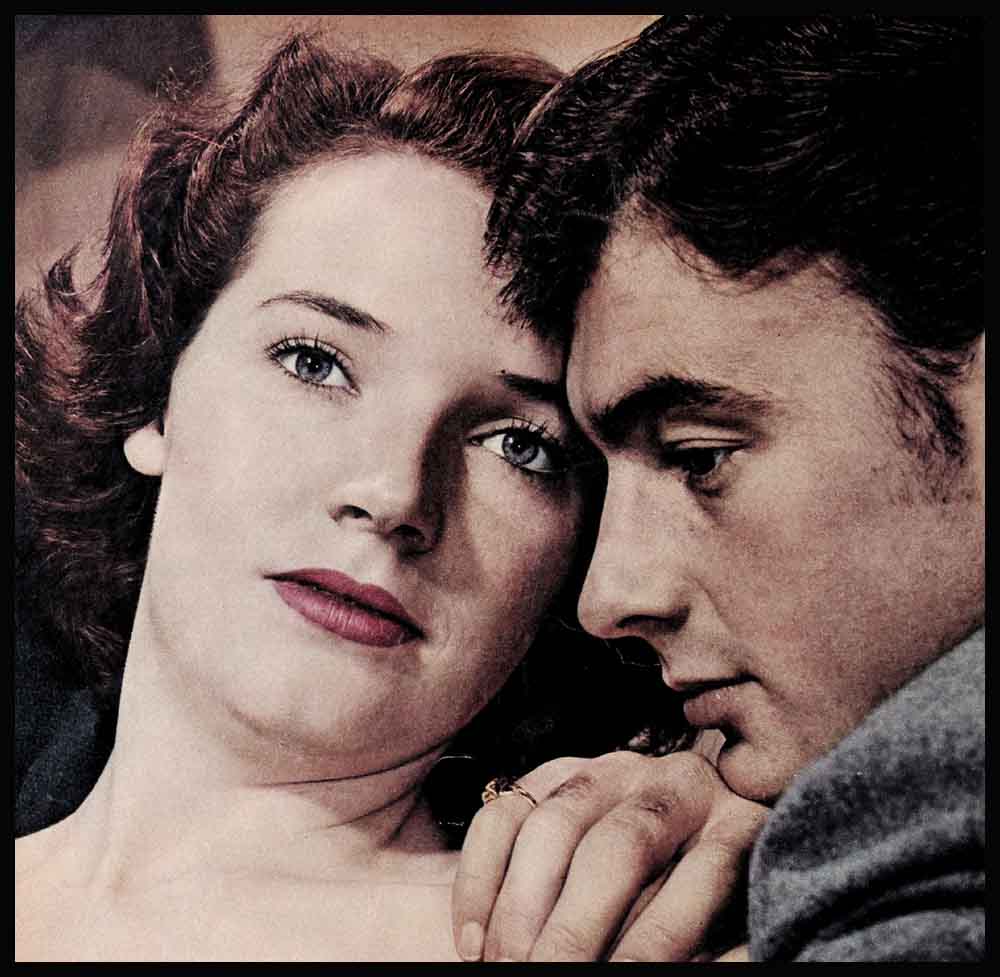
An Intimate report On Hollywood’s Young Marriages
You find young couples all over the vast, sprawling terrain of Hollywood, in Mandeville Canyon, on Vine Street and out in San Fernando Valley, They live in every kind of place, from the modern house of Diana Lynn and John Lindsay which I John designed, to the tiny walk-up apartment i with a ten-by-sixteen living room which Corinne Calvet and John Bromfield rent. The decor ranges from super-modern to chintzy early American to Greenwich Village leopardskin.
Yet the principal young married couples of Hollywood have this in common. They are all earnest young people, trying valiantly to make a success of marriage and to keep romance alive.
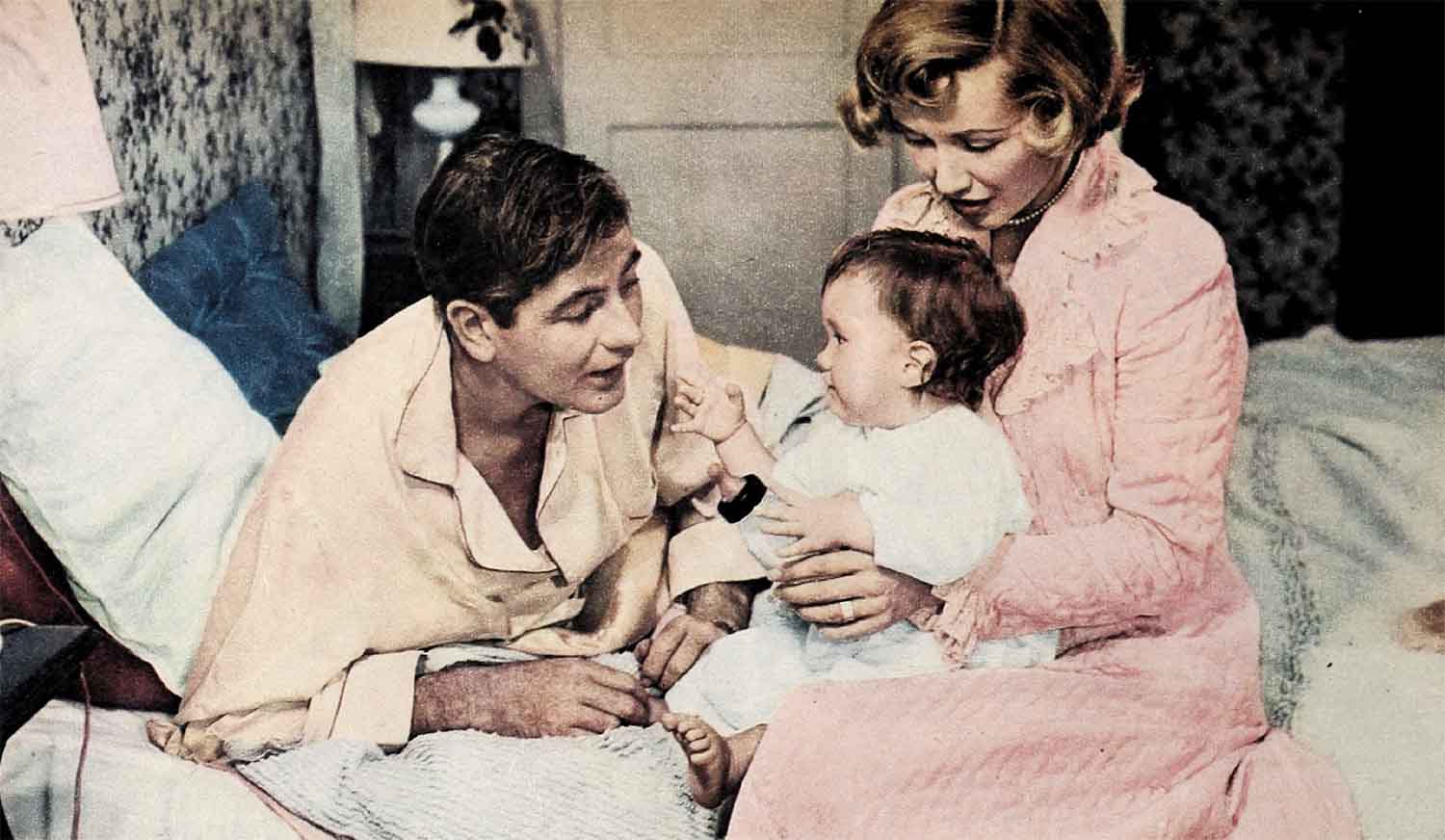
Believing that you would not only be interested in how they live but that you would like to know how they face their problems, the editors of Photoplay compiled a comprehensive list of intimate questions as a basis for this survey of the film colony’s young-marrieds. They disagreed on all subjects but one—the home. Those who do not already own their homes are saving to buy homes. Probably in no other community is the percentage of young home owners so high. This is partly economic but it also stems from the fact that the home, the roots of a marriage, is important to these kids.
The Budget Problem
There was no budget plan figured out before the Don Taylors married. “How could we?” Phyllis Avery asks. “Don was in the Army. It was catch-as-catch-can. Besides, he had a lot of my bills to take over.” Gene Nelson said, “We didn’t have a home. Miriam and I were on the road and we lived in hotels.”
Keefe Brasselle didn’t start married life with any budget plan but he’s on such a strict budget now that he is not allowed to write a check. Keefe is a spendthrift—“I’m the big hot-shot guy who always reaches for the check.” So Norma, with Keefe’s consent, took his account away from him. He has ten dollars a week spending money. For the first six months of their married life Diana Lynn and John Lindsay had no budget. Then they realized they were spending far too much for rent. They made a budget and moved into a house that architect John had built “on spec.”
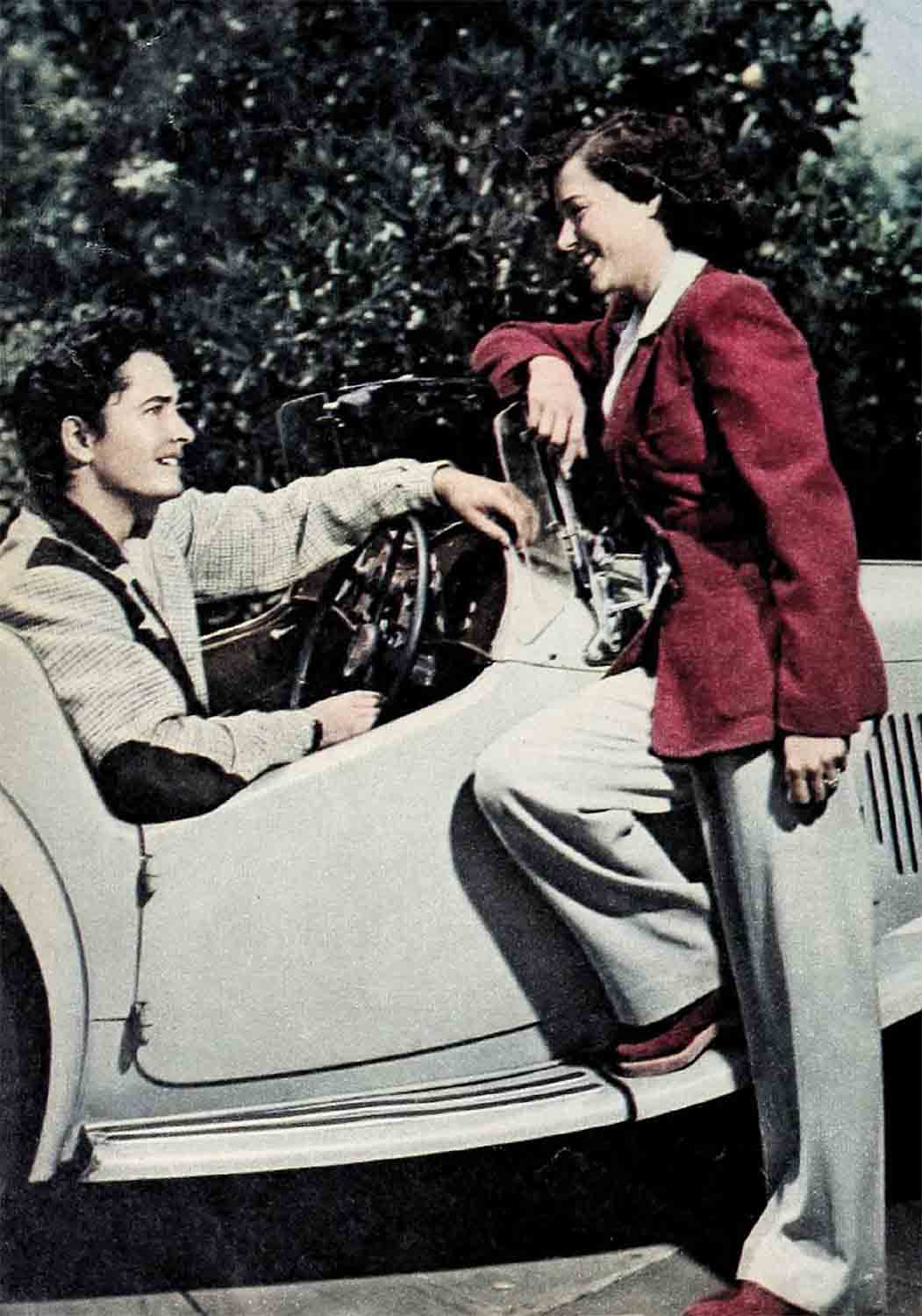
Newlyweds Jerome Courtland and Polly Bergen had a budget until, as Polly explained, “The refrigerator went on the blink and we had to eat out, so the budget was shot temporarily.” But Jean Hagen and Tom Seidel—he was once an actor, hated it, and is now a writer—are, as he says, “just not the kind of people who budget.” Don Taylor believes, “Budgets, like laws, are made to be broken.” Whereas Marsh Thompson asks, “How can you look toward the future unless you know where the money is going?” He and Barbara were one of the two couples who worked out a budget plan before marriage.
Who Pays the Monthly Bills?
Barbara Thompson pays the bills because, “Marsh just hates to write out checks.” Tom Seidel does it because Jean Hagen is awful at it. When Tom was away recently, settling his father’s estate, Jean took over. She is so used to having him take care of everything that the bankbook went to pieces. The night before Don Taylor came back from a six-weeks location, Phyllis stayed up until four a.m. trying to balance the check book, which Don usually keeps. Geary Steffen handles the bills but he and Janie check them together. Corinne Calvet was shocked by the question. “John writes out the checks, of course,” she said. “That is the job of the man.”

How They Save Money
Half of Marshall Thompson’s salary goes into savings. So does a fourth of Jerry Courtland’s. Insurance is the biggest investment. “Naturally for us,” says Janie Powell, “my husband is in the insurance business.” Although Diana Lynn has an annuity, most of her and John’s money is in real estate. In fact, they are in business together and plan their strategy in the evening. He builds houses and takes the second mortgage and they invest an equal amount in the project.
John Derek and Patti had a big savings plan but it went right out the window when it was discovered that their baby, Russell Andre, was born with a misplaced esophagus. This necessitated a series of operations which have left the Dereks in debt. They have managed, however, to hang onto insurance for the baby. A lot of the couples have business managers who handle their investments. Corinne Calvet doesn’t need a business manager because, “Johnnie is so clever.” They save cash because they want to buy a home.

Quarrels
Don Taylor’s wife, Phyllis Avery, says, “Don and I don’t have many quarrels. When we do, we yell briefly at each other and it’s over.” Marshall Thompson says he and Barbara do not have them, that they never have raised their voices against each other. But he adds, “Sometimes Barb gets mad and doesn’t speak. I ignore her and the anger is gone in ten minutes.” Janie Powell is another who says, “We don’t have quarrels. Geary won’t argue.”
But red-headed Polly Bergen, Jerome Courtland’s wife, is Irish. She says, “If I didn’t fight with a person I wouldn’t love him. It’s natural for people in love to fight.” Both she and Jerry are strong-willed. He also has an extremely high temper. But they have learned to laugh off their quarrels and they always make up before they go to bed. When Joan Leslie, who is pregnant, and Dr. William Caldwell disagree, they talk it out reasonably. “Never have an argument when you are tired or not feeling well,” Joan says. “Nothing should be discussed at such times.”
When Norma and Keefe Brasselle quarrel, he just walks out of the house. “But Normie never forgets,” he says. “Even when I come back I have to make up with her. If I hurt her feelings when we’re out—the evening is over.” Philip and Phyllis Shawn went to grade school and high school together. They married when they were eighteen. Phil, who becomes a star with his first picture “The Sun Sets at Dawn,” says, “We know each other so well and have known each other so long we can see when quarrels are coming up, so we divert each other and talk of something else.” The disagreements between Diana Lynn and John Lindsay just seem to blow over. “But,” Diana says, “we never say anything to each other that can’t be taken back.”
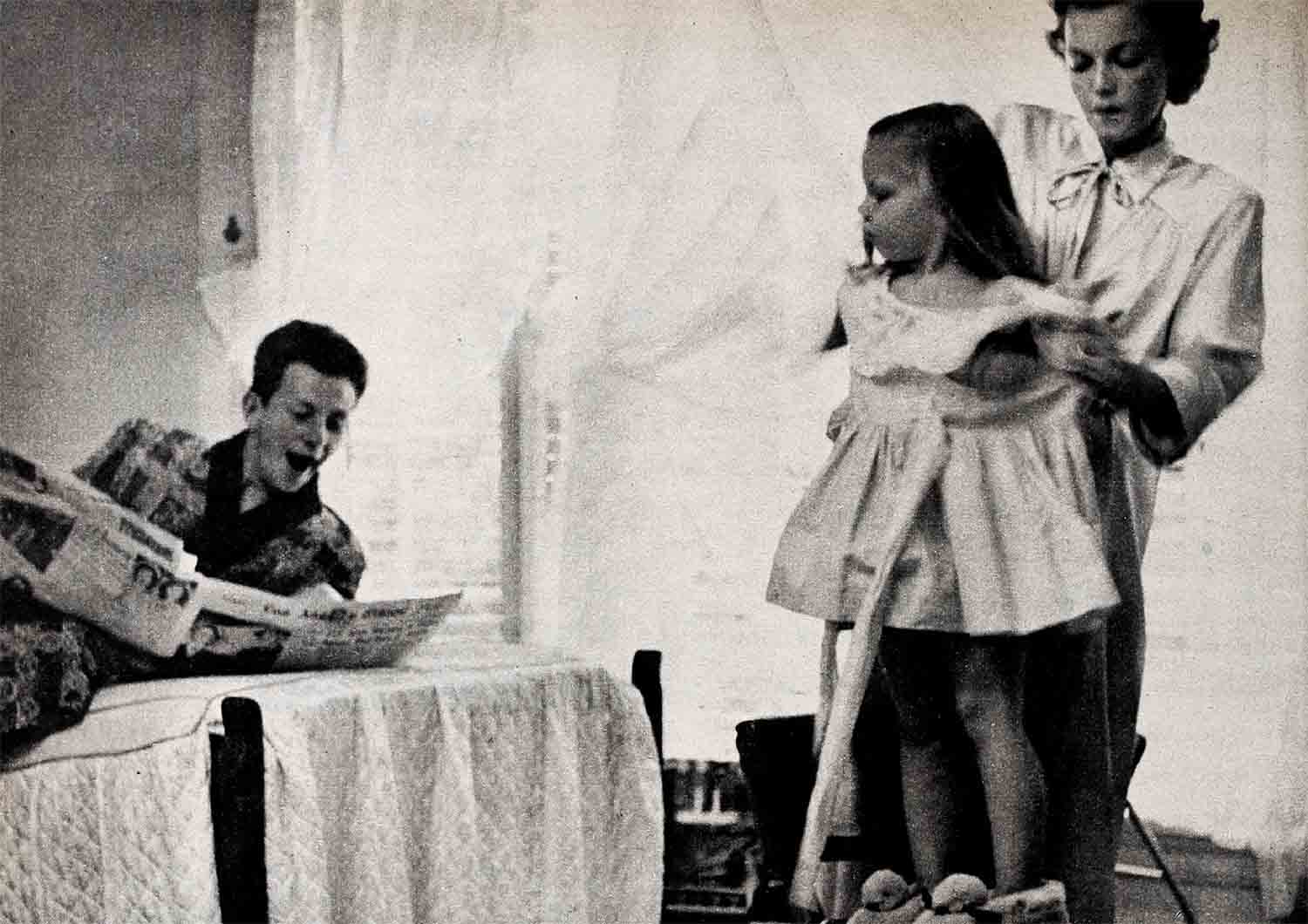
Gene Nelson expects his wife, Miriam Franklin, to cure the quarrels. She expects him to. “So we don’t do anything,” Gene says, “and both of us sulk. Then one of us says, ‘Well-l-l?’ and we both laugh.” However, the Nelsons have not had so many quarrels since the baby came. They don’t want Chris to lose his feeling of security by thinking back to a fighting family. The marriage of Donald and Gwen O’Connor was a difficult one. He was eighteen, she sixteen and he went immediately into the service. They even separated once. But now, things are much better. They blow their tops during a quarrel, then forget what it was about.
John Derek’s wife, Patti Behrs, is French. She says, “If I start a quarrel and he gets really mad I shut up. If he is only a little mad I keep on nagging.” But leave it to Corinne Calvet to put the topper on the question: “When I start a fight, Johnnie just picks me up in his arms and takes me away and I can’t go on any more!”
Jealousy
Miriam Franklin Nelson thinks Gene is “over friendly.” He says he just likes to have fun. Turning to Miriam he said, “There’s no need to be jealous of Doris Day.” (He’s making a picture with her and Miriam is a dancing coach.)
“I’m not jealous of Doris—she’s my friend. But comes the next girl—I don’t know.” Miriam says she tries to control her jealousy. Gene says, “It’s just silly.”
According to Diana Lynn, John Lindsay is too “well adjusted” to be jealous. Diana was jealous at first but once she realized there was no reason to be, she forgot it. John Derek was never jealous of Patti but she “used to be.” Then she “just got over it.” Norma Brasselle isn’t but Keefe is and once almost took a poke at a guy who was staring hard at Norma. Then he realized the guy was bigger than he was—but Keefe’s evening was ruined.
When Pat Nerney is jealous of Mona Freeman—and she isn’t of him—he just blurts it out. Mona thinks that’s the only way. “And you’ve got to answer honestly,” she says. “That’s the only way, too.” There is no jealousy between Joan Leslie and Dr. Caldwell. She works in pictures with men. He, being a gynecologist, sees a great many women. They both understand this is strictly business. Corinne Calvet believes there is no real love without jealousy and doesn’t try to overcome it.
Probably the most jealous husband in town is Jerome Courtland. He turns green when Polly has to do a love scene. Knowing this, everyone kids him, tells him how much feeling Polly puts in the scene. Polly tells him he is childish but she kids him, too—telling him that some of the young men with whom she plays love scenes kiss better than others. Then he blows his top and there’s one of those wonderful fights they both love.
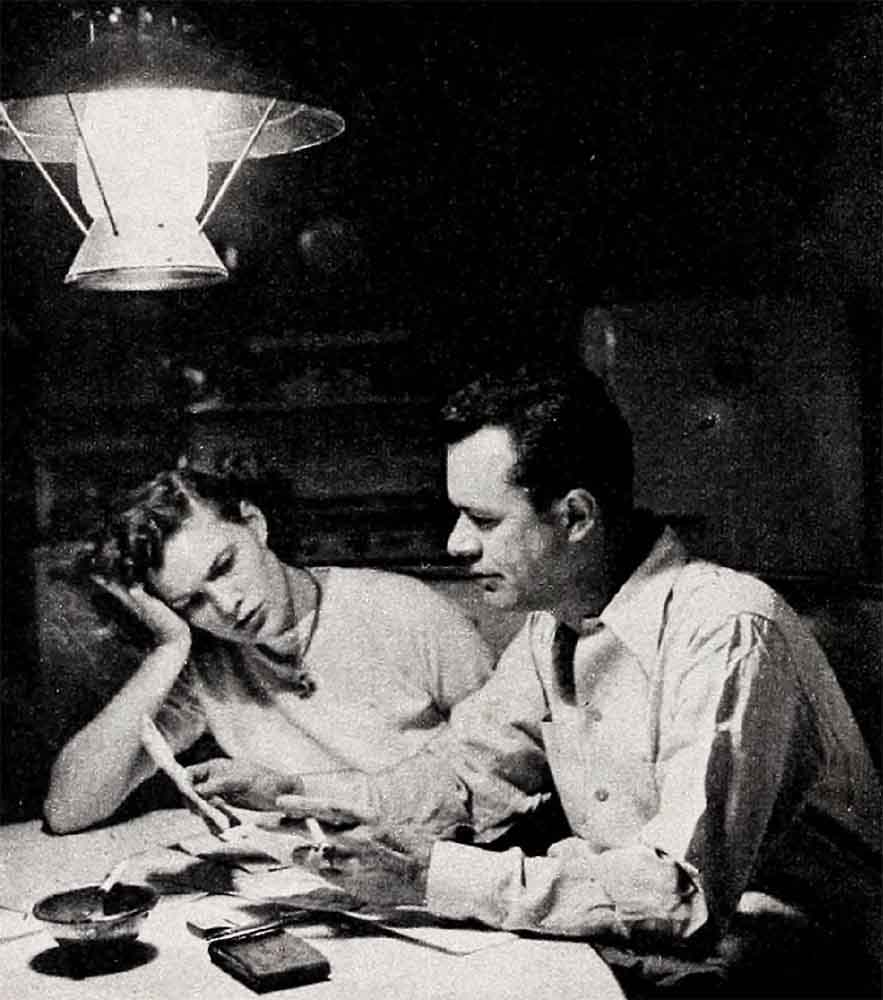
Romance after Marriage
Practically none of the young marrieds have a definite plan for keeping romance alive. Patti Behrs said she would “trust to luck.”
Mona Freeman was practical. “This quote keeping romance alive unquote is a lot of nonsense,” she said. “When the first flush of romance goes, better things take its place.” Corinne Calvet examined the question with amazement, spread her hands in a broad gesture and said, “But I’m French!”
In-laws
Some families help the young people. Joan Leslie’s father gave her and Dr. Caldwell the refrigerator and stove for their new home. Gene Nelson’s mother helped to buy the Nelsons’ house. However, Gene has loaned his family money from time to time. Same way with Keefe Brasselle. “But I’ve probably borrowed ten times as much from my mother as she has from me.”
Mona Freeman doesn’t need to make a production of family entertaining. The families live close by, they see each other often and Pat is in his father’s automobile business with him. The families of the Gene Nelsons always come to the kids’ house because they want to see young Chris in his native haunts.
Since Janie Powell and Geary Steffen got married the two families have become intimate friends. Janie usually has both families together to dinner. The only two who have regular days to see the family are Marshall and Barb Thompson. On Mondays they go to Marsh’s family, on Tuesday nights to Barb’s. Now that they have bought a house Barb will return these invitations. As for holidays like Christmas and Thanksgiving the young people go to their families’ homes. Keefe Brasselle always takes his mother out to dinner on Mother’s Day.
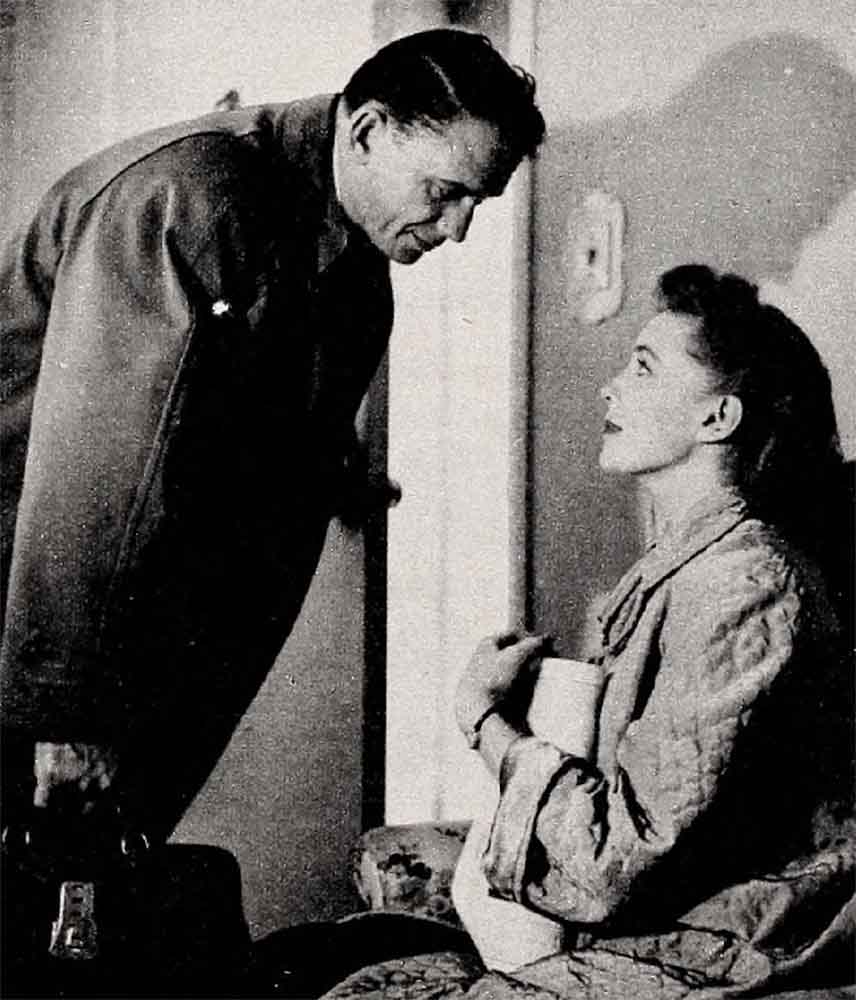
How They Shop
Usually Hollywood young marrieds shop for household furnishings together. The Keefe Brasselles not only shop together for household things—they make them together. Having just bought a house in The Valley, they have scoured the countryside for old pieces. A dry sink is being refinished by Keefe to become a cabinet to stand in the bay window. And Norma makes slip covers and upholsters the chair seats. But Mona Freeman says her husband, Pat Nerney, is the shopper in their family. He even buys all her clothes himself and without her. Mona was a poor girl; Pat comes from a wealthy family. Mona could not bring herself to buy expensive clothes and Pat believes, “Buy it good or don’t get it at all.” Mona works hard at the studio. Since Pat works every other night he often has time off during the day, so he does all her shopping and she loves it.
Miriam Franklin would like Gene to go with her but he doesn’t. “She always goes to the most expensive dress like a homing pigeon,” he says, “but her taste is wonderful and she creates styles. She wore a baby blanket thing like a shawl to the opening of ‘Lend an Ear’ and a few months later stoles were the rage.” Miriam goes with Gene when it’s convenient but Gene hates the time and money clothes take. He used to love clothes but since they’ve bought a house, he’d rather have a gardenia plant.
Jerry Courtland has revolutionized Polly’s way of dressing. He did not like her sophisticated black dresses and high-heeled shoes. So now she’s wearing casual peasant blouses and skirts, slacks and sandals. Philip Shawn always chooses Phyllis’s clothes.

John Derek doesn’t go with Patti but he often buys things for her. He went to Mexico recently to see a bullfight and came back with a Mexican skirt with a bullfighter painted on it. John Lindsay doesn’t go with Diana Lynn but almost always likes her choice. There was one great exception. She bought an elaborate evening dress with beads on it. He said, “You look like a lamp shade.” So the dress went into the closet where it remained until Diana went to New York alone and wore it there. She hopes to spring it on him later. “But,” she says, “he has the memory of an elephant. I probably won’t get away with it. Know anybody wants to buy a beautiful dress—size ten—with beads?”
Although Geary doesn’t go with Janie she shows him swatches before she has her clothes made. Jane is so tiny she cannot wear clothes out of the store. Although she dresses for him, she will sometimes have a dress made up even if he was not crazy about the sketch, knowing he will like it when he sees her in it. And Janie doesn’t go with Geary because, “I don’t know much about men’s clothes and he knows it.”
Polly Bergen hated Jerry’s clothes as he did hers. “He was strictly the blue jean and T-shirt man,” she said, “and he had one awful sports jacket.” She made him buy several conservative suits.
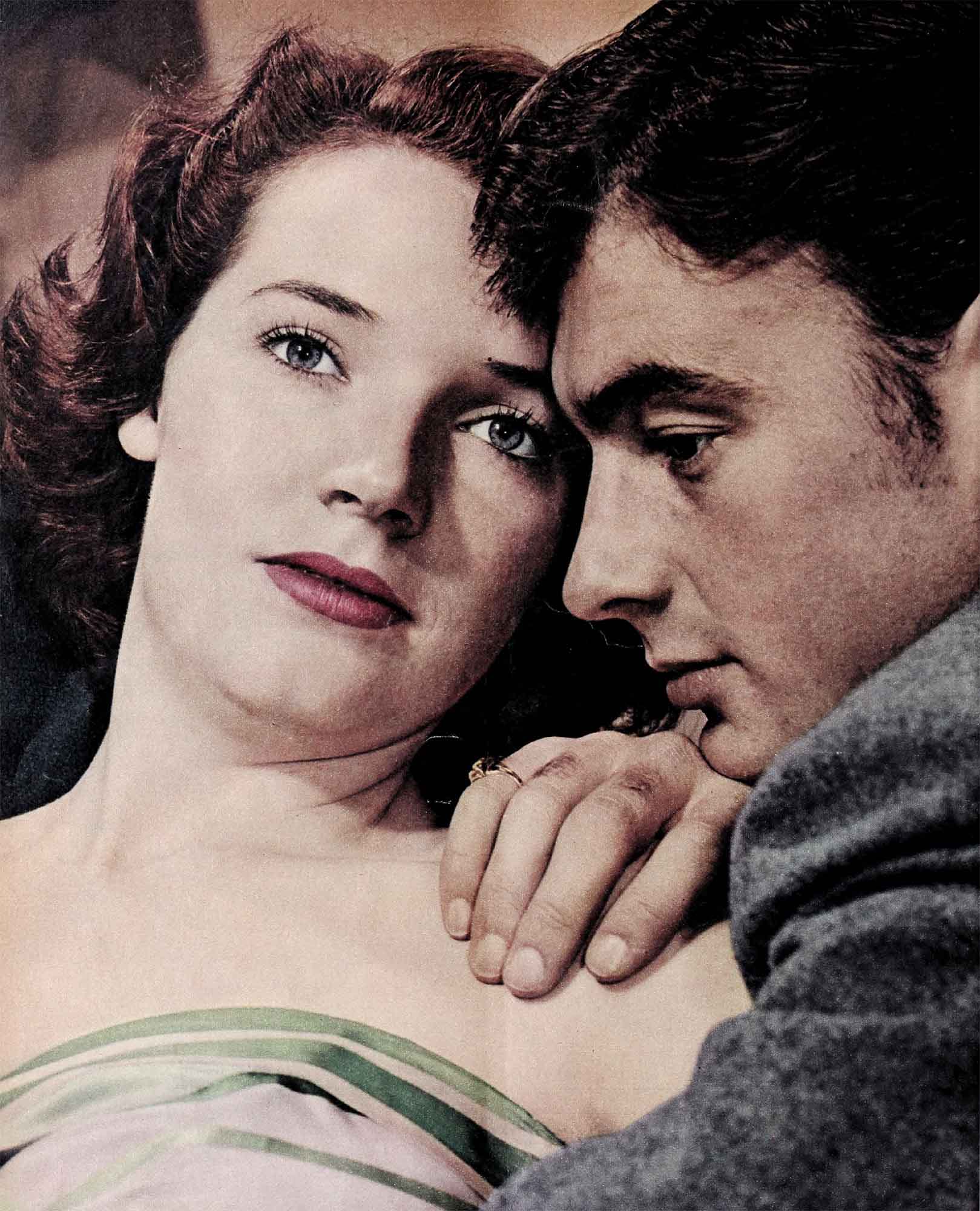
Entertainment
Movies, movies, movies. The young marrieds of Hollywood are crazy about movies. John Bromfield only likes good ones but Corinne likes movies even if they are bad. Of course, this is natural since seeing movies is part of their job. Next to movies as entertainment is going to friends’ houses and having friends in. Joan Leslie and Dr. Caldwell go to baseball and football games a lot since he was a football player and a coach. She had no interest at first but now loves these sports. And they go dancing. “Bill is a beautiful dancer,” she says, “and so few men are today. Why, he can even waltz.”
Janie and Geary, besides movies and friends, occasionally go dinner dancing a a place like the Cocoanut Grove but, “we don’t go to night clubs unless we’re invited.” Diana Lynn and John Lindsay feel the same way about it. And the Keefe Brasselles only go night-clubbing when there’s a special occasion like the Press Photographers Ball. They all go to premieres and to the theater. The Don Taylor are the only ones who play a lot of bridge with their friends, who are mostly writers.
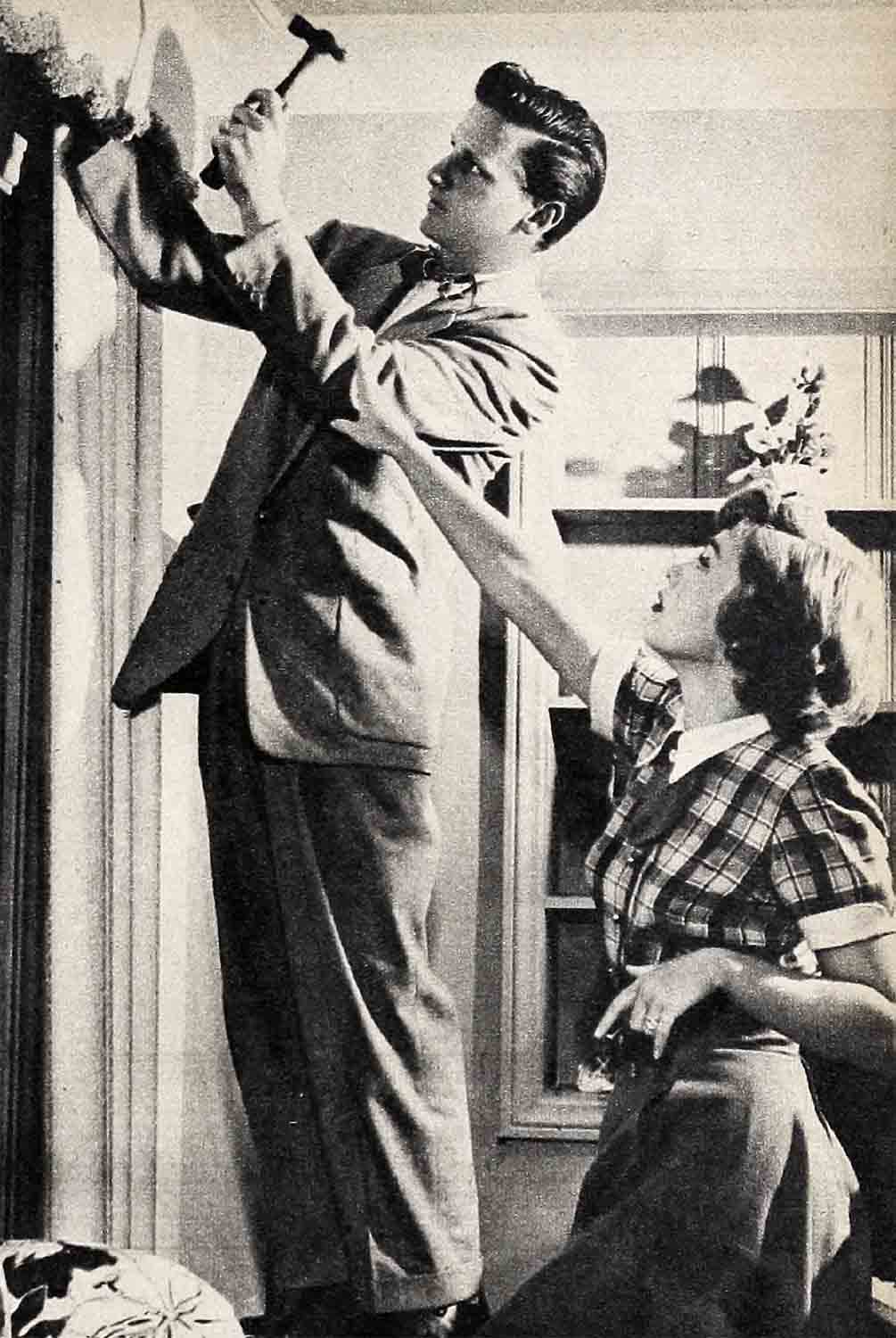
Evenings at Home
Mona Freeman finds herself alone lot in the evening because Pat work every other night. “You sell more cars a night than any other time,” he says. Mona reads or looks at TV. Norma Brasselle irons while Keefe polishes his shoes and answers his mail. Janie and Geary play canasta or, on rare occasions, he works at home. “Not often,” she says, “Geary’s so smart he can get his work done at the office.” When he does work at home, Janie types for him. Diana Lynn and John Lindsay work together on their business project.
Phyllis and Philip Shawn study nonsectarian religious science together or he writes poetry. A book of his poems, “My Eyes Are Open” is now with his agent in New York. He writes under his real name, Pat Waltz. Marsh Thompson works in a neighbor’s shop or he and Barb work on the plans for their house while Gene Nelson makes tape recordings of Chris’s little voice.
Donald and Gwen O’Connor have a variety of “evenings in.” They look at TV while Donna, aged four, sits on the saddle given to her by Gwen’s father. Or Donald writes and Gwen knits. Also little Donna loves to dance to the music of her father’s guitar. At the moment the O’Connors are going on a personal appearance tour and have been working on their dance routines and skits.

His Night Out
Regularly once a week Keefe goes to a sporting event usually with his friend Anson Bond, while Norma sits with their daughter—christened Erin but called Mickey. Then once a week Norma has a night out. She goes to a show with her girl friend, Betty Ward, and they have an ice cream soda at Wil Wright’s afterwards while Keefe sits. Once a week Geary Steffen has a business meeting and, since he’s in the Reserves, he spends one night a month at the Armory and a weekend every month at Fort McArthur. That’s when Janie has girl friends in to talk.
John Lindsay wants to get his national architect’s license—he is already licensed in several states—so he works with an architect friend one night a week. It is then that Diana has a dramatic class. Joan Leslie’s husband has so many nights out she’s used to it. He has physicians’ meetings, alumni and committee meetings—besides the unexpected night out when duty calls. When the call comes she will ask, “Is it a first baby?” The first babies take longer. If it’s a second or third she may be able to save the meat loaf.
Pat Nerney occasionally goes out for a game of poker with the boys—protesting that he hates it and would rather be at home with Mona. “But I think he has a pretty good time,” Mona says. When Corinne Calvet was asked if John had a night out with the boys she said, “He does not. I’m the fellow he wants when he wants a fellow.”
Children
Mona Freeman says, “I’d like one more. If there’s a third—fine. But I must have two.” Mona has definite ideas about her child’s sense of security being protected even though she is away from home. “It i isn’t the amount of time you spend with your child that counts,” she says, “it’s what you do with the time. Give a child love—oh, plenty of love—and a sense of humor and that’s better than spending a lot of time if you nag or seem worried or tired.” Right now, little Monie, aged three, has a real sense of humor.
All of them want children and the ones who are already parents want more. But they have no planned family ideas. Miriam Nelson would like a girl—they already have a boy—then see if she wants more.
Gene and Miriam Nelson have adjusted , Chris’s schedule to theirs. He gets up at nine—or when they do—and stays up until nine at night. In this way they are with him a lot. The doctor said so long as he received the proper amount of rest this was all right. Also, ever since Chris was a tiny baby they have often taken him with them to lunch and dinner at restaurants to make him feel he was sharing their life, that he belonged.
Diana Lynn and John Lindsay want three. John Derek wants two more and Patti will settle for one.
Joan Leslie, who was pregnant when interviewed, wants “a large family.” Joan says about her coming baby, “If my career should ever interfere with my child’s security then the career goes out the window.” Janie Powell won’t stop with her first—she says she wants three, four, five or six. Corinne Calvet wants a “beeg family” and would like twins and, this is what the lady said—“to kill two stones with one bird.”
The Don Taylors are the only couple with two—both girls, Avery and Anne. They wanted children desperately but she lost two before Avery was born. She has to spend her pregnancies in bed. Talking about it, she turned to the eldest girl, “I was so glad to see you, Avery, I never thought I would.” So far, Phyllis and Don have not worked simultaneously so when Phyllis is gone, Don plays at being the mother. Phyllis and Don have a housekeeper but no nurse. “I didn’t bring them into the world so laboriously,” Phyllis says, “to nave someone else take care of them.” Only recently has Phyllis worked in pictures. They are used to Don’s arrival in the evening. But one day Don was home with them. When Phyllis walked in late, Avery said, Hello, Daddy.”
Jean Hagen said, “Up until the time I had this infant I thought I wanted six. Now I think an only child isn’t so bad but really, I want more.”
Jean lets her baby feel the house is his. “There’s a bassinet in the living room and a clothes line across the patio, fastened to the barbecue pit. It curtails their entertaining. “But what,” Jean asks, “is a barbecue pit compared to a baby.”
Economies
Keefe Brasselle’s pet economy is paper and, “Normie drives me crazy. She’ll fill up the whole telephone pad with just one message. If she makes a mistake when she’s writing a letter she won’t correct it—oh, no. She’ll throw the whole page away.” Norma believes in economizing by cutting everything in half. If you want two books, buy one instead. Same way with magazines and clothes. She doesn’t believe in economizing on food. Curtail nights out to dinner instead.
The John Dereks economize on food and clothes and Patti conceals the food economy with wonderful French sauces. She also looks very cute in peasant skirts and blouses. Miriam Franklin saves her old clothes and has them made over attractively. Whereas Corinne Calvet does her own hair and nails. Corinne and John have another economy that is anything but dreary. When they want to go out on the town of an evening they go surf fishing instead. “We have so much fun,” Corinne says, “and free fish for dinner next night.”
Janie Powell does her own marketing, watches all the sales, buys all the “specials.” She and Geary decorated their own house, bought their furniture at auction and painted the fence themselves. Janie waxes the kitchen floor and loves it. “It’s the attitude you take,” Janie says. “Being economical is fun. You’re building.”
When Marsh Thompson and Barbara get into their new house they won’t have any moving bills. They will hire a truck and a trailer and gather their closest friends together—Janie and Geary, Jerry and Polly Courtland, Roddy McDowall and Barb’s brother. The kids will move all the furniture and it will be a party. Barbara is a little worried. “What if the furniture gets scratched or something is broken?” Marsh reassured her, “When we moved Janie and Geary nothing was broken. I think we’re more careful than movers.”
“Can we get insurance on a move like that?” Barbara asked. “I’ll look into it,” Marsh said.
Extravagances
With the Don Taylors, Christmas is the big time. They go “hog wild” giving presents to each other and the kids. Jean Hagen and Tom Seidel blow hot and cold. One week they are very economical, the next wildly extravagant.
Diana Lynn admits that she loves clothes. She does have a budget and stays within it but it’s pretty big. “I tell myself,” she says, “that it’s part of my job to have pretty clothes and lots of them. And John was wildly extravagant on our honeymoon. But we’d rather have those wonderful memories than money in the bank.”
Philip and Phyllis Shawn can’t resist buying books. Jerry Courtland is a camera fiend. He justifies the expensive ones by saying he is going into movie production one day and they are an investment. Jane Powell has a yen for shoes and Barbara and Marsh Thompson think they spend too much money taking trips. Corinne Calvet, a French gal, has no extravagances.
That First Year of Marriage
Norma Brasselle thinks the first year of marriage is the hardest because of the need to make adjustments to each other. But Keefe said, “Everything gets tougher. You have more worry at option time and every time. And men aren’t used to responsibilities and resent them. But make no mistake, it is the woman who keeps the marriage together and Norma is the level-headed one.”
For the Donald O’Connors the first year was terrible—with Don in the Army. The Gene Nelsons thought the first year was “a ball”—they were in road shows together and had no worries. Diana Lynn thinks the first year is like this: “You read all the books and knock yourself out for the first year. Then you take off your shoes and relax and get so secure you don’t worry any more.” Jerry Courtland’s mother gave him and Polly a book called “Ideal Marriage.” They both read it but still think the first year is the most difficult.
Janie Powell says, “If all the years are as easy as this one I’ll be more than satisfied.” Corinne Calvet said, “The reason marriages break up in the first year is because the girls are foolish. Every girl in her teens wants to run away from home. She’s not allowed to. So older girls want to run away from marriage. But you must make the marriage stick. You can’t run away from it.”
Individual Problems
What about the girl who marries a doctor? Joan Leslie says, “If you fall in love with a doctor you have to adjust to his hours and the fact that he may be called away in the midst of a dinner party. If you say, ‘Oh, no! Not again!’ you might as well give up. Face this problem before you marry him.”
Jean Hagen and Tom Seidel have solved the problem of the danger of keeping the family dog after the baby arrives. Tom figured this one out. When Jean is holding the baby Tom pets the dog and when Tom holds little Christine, then Jean plays with the pooch. “In this way,” Tom says, “you keep him from being jealous. He will never attack the baby. Instead, by feeling secure, he will learn actually to protect the baby.”
Donald and Gwen O’Connor faced the problem of separating and going back together again. “It was not too difficult,” Gwen said. “We both knew we had made mistakes and we were both ready to rectify them.”
Don and Phyllis Taylor had the second child problem. How to keep Avery from being jealous of Anne. They taught Avery to ape Phyllis. When Phyllis gives a bottle to the baby, Avery gives her doll the bottle. In this way she is important and participates. In fact, Avery calls her doll “baby.” Phyllis wanted to name the doll but Avery wouldn’t have it. There has been no jealousy.
And there it is. These couples have more money than the average, certainly but they’re level-headed. The lean years most of them knew taught them to face life realistically—and to expect problems—and to work them out.
Don Taylor is in “Father’s Little Dividend”; Phyllis Avery in “Queen for a Day”; John Derek in “The Hero”; Gene Nelson in “Lullaby of Broadway”; Marshall Thompson in “Dial 1119”; Donald O’Connor in “Double Crossbones”; Jean Hagen in “No Questions Asked”; Keefe Brasselle in “A Place in the Sun”; Jane Powell in “Royal Wedding”; Jerome Courtland in “Santa Fe”; Mona Freeman in “Dear Brat”; Diana Lynn in “Bedtime for Bonzo”; Corinne Calvet, a Hal Wallis player, next in “Quebec”; Philip Shawn in “The Sun Sets at Dawn”; Joan Leslie in “Born to Be Bad”; Polly Bergen in “Warpath.”
THE END
It is a quote. PHOTOPLAY MAGAZINE FEBRUARY 1951




